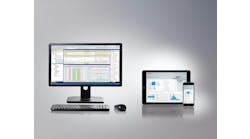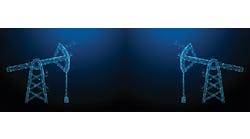Everything is still going through pipes and in and out of tanks. It's the ability to know more sooner and make better choices that's changing fast.
"Time-series data (TSD) is essential for our jobs and decision-making, but it's typically difficult to do. We can perform data dumps with time stamps and send it to a graph, but it's hard to tell what the data’s story is in two columns on a Microsoft Excel spreadsheet," says Aubyn Chavez, process improvement engineer, Process Improvement Group, Cornerstone in Waggaman, La., near New Orleans. Cornerstone produces acrylonitrile, melamine, sulfuric acid and urea, and supports the utilities of three neighboring tenants at Cornerstone Energy Park. "Our current trending tool, PI Processbook, has been available for many years, and we still use it to add time frames to data and see if there are correlations, but it's still very restrictive and basic. In Excel, you may be able to make some useful calculations, but it's usually a very cumbersome and slow process.
"The hardest part of data analytics is data wrangling and trying to find correlations for normal operations. This is a difficult task without efficient tools to perform calculations and reach conclusions. More recently, trending software lets us process information faster, maintain trend views, and filter data for specific needs to prove or disprove operating theories, such as why a temperature spike happened."
Starting with steam
While its processes include catalyst bed reactors, urea reactors, recovery sections and scrubbers, Chavez reports she's been focusing on the plant's steam boilers, which are part of the Process Improvement Group's support for data analytics and digitalization efforts by Cornerstone's engineers across the site. They use OSIsoft's PI AF software to build KPIs and metrics, and put them on a dashboard using PI Processbook. These KPIs and calculations can also be viewed with TrendMiner's software for diagnostic/exploratory analytics, which is quicker than using spreadsheets.
"In the past, we had a huge mass of Excel spreadsheets, and it took days and weeks to prove a process theory and improve a process," explains Chavez. "We began looking for a new method in 2019, tried out several, and started using TrendMiner last year. It first helped with descriptions on the analytics side by allowing us to add tags on top of existing processes, and was also good for developing better user interfaces. More Cornerstone employees got involved and excited when they saw what the software could do, and we pushed for an initiative, so they could gain proficiency, and support our unit engineers who don't always have the time to learn new technology.
"We adopted TrendMiner's statistics and machine-learning (ML) capabilities, which let us manipulate data the way we want. Questions that previously had to be addressed at a slow pace can now be answered all at once. For instance, we had a reboiler fouling more frequently and it was theorized that there was some solid carryover as a culprit. Previously, it would’ve taken quite a bit of time to prove or disprove this theory. Now, we can examine them right away."
Nick Petrosyan, customer success manager at TrendMiner, reports data science and analytics software grew up along with information technology (IT) as it and the consumer market for its technologies evolved from the 1990s through the 2010s, while the manufacturing level lagged behind, until they started trying to catch up in recent years, particularly with more recent efforts like the Open Process Automation Forum (OPAF) and its standard-of-standards initiative.
"The process industries began to see the value that faster data analytics could bring to their subject matter experts, which is why TrendMiner focuses on enhancing experts' toolboxes beyond Excel and traditional trending tools," says Petrosyan. "Much of the software SMEs use was pioneered in a time where PCs didn't have much power or memory, but as technology has advanced, it's given companies like us a chance to add advanced computing capabilities like advanced data searches and mass-scale correlation calculations."
Eliminating suspects, prejudices too
Beyond improving basic operations, Chavez reports that today's data analytics tools can also help users search for more elusive variables and models and evaluate them to prove or disprove their assumptions and usefulness.
"We can quickly get the right data tags to find the catalyst carryover from six reactors and build temporary tags that can sum up all the tags for catalyst lost," says Chavez. "By creating new tags for catalyst lost, we can trend them against the reboiler's chest pressure, and learn if it's increasing due to fouling. We can also quickly filter out when a reboiler is out for servicing, look at the times it was operating OK, and calculate the rate of catalyst lost and if it correlates with frequent fouling, supporting the theory."
Thanks to its new analytical capabilities, Chavez reports her team and Cornerstone's other engineers were able to disprove a theory that there was a significant correlation between catalyst and reboiler fouling by using reactor readings taken over a period of time.
"The number one task in data analytics is wrangling information, making it reliable, and confirming it reflects existing operations. In this case, we demonstrated there was no correlation between the catalyst and reboiler fouling because TrendMiner let us show the readings with total realism,” explains Chavez. "We proved our initial suspect was innocent, and followed-up to make sure our data was accurate. This is freeing us to look at other reboiler items, such as checking transmitters and pursuing other suspects. The most compelling and sexy thing about data analytics is finding smoking guns. However, what's more important is that it lets us work more intimately with our process applications, and it facilitates dialog across other professional disciplines such as our process control and instrument engineers, which is especially important because we have many more young engineers coming in."
For process end users who want to digitalize their data analytics, Chavez advises that software like TrendMiner can enhance or accelerate process knowledge, but it can never replace it. "You must still know your process, so you can incorporate context during data wrangling, make sure it’s reliable, and identify the trends that come from it," says Chavez. "Analytics software is better than spreadsheets because it lets us work faster by highlighting process details better and lets us disprove our traditional prejudices."






